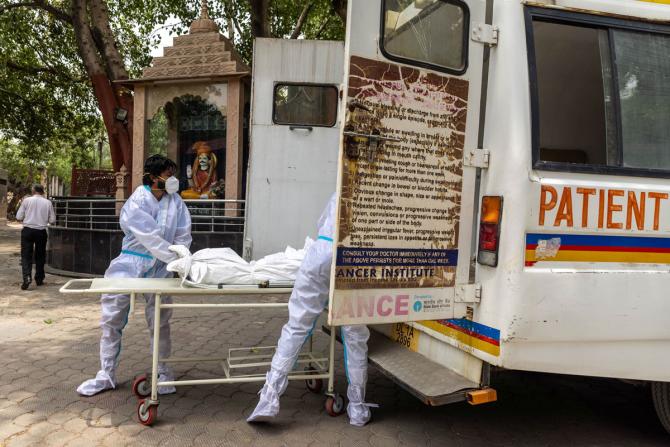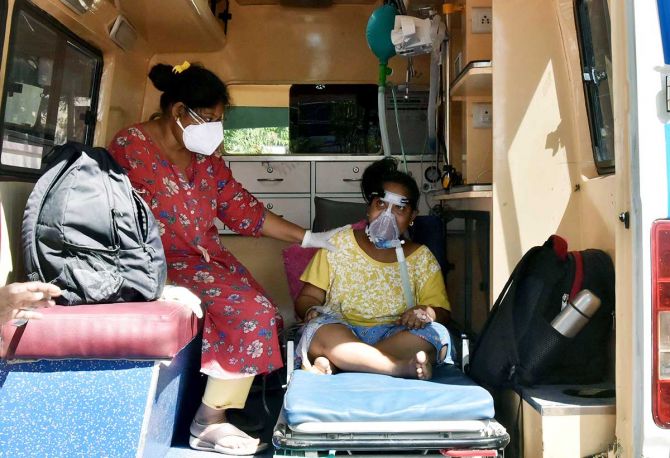'The second wave was more virulent, more aggressive.'

As, to our relief, the second wave of COVID-19 slowly wanes and the numbers of the sick and dead mercifully decline, many questions remain.
Were the vaccinated dying because of COVID-19?
Or did a health system, that could not cope, do them in?
Were those, who were admitted in hospitals with COVID-19, but died after several weeks in the hospital from sepsis, DVT etc, victims of COVID-19 or the system?
How much higher were the mortality rates from this variant of the COVID-19 virus and why?
In the second of a three-part conversation with Rediff.com's Vaihayasi Pande Daniel, Epidemiologist and doctor of internal medicine Dr Shriprakash Kalantri carefully and astutely weighs in, with answers to these questions.
Professor of medicine and head of Mahatma Gandhi Institute of Medical Sciences, Sevagram, Maharashtra, and medical superintendent of the Kasturba Hospital, Wardha, with more than four decades in the field, Dr Kalantri is one of the doctors who has been vigorously lobbying for the Indian Council of Medical Research to rationalise its guidelines for treatment of COVID-19.

Initially, last year, there was an issue that the cause of death was usually almost always COVID-19, but it was listed wrongly on death certificates as something else, like heart failure etc.
But now one is hearing of people, who've had one or two vaccines, who are still dying of COVID-19, usually, after a long stay in the hospital.
Are they dying from COVID-19? Or maybe the cause of death is not actually COVID-19 anymore?
So, there are two things which we need to keep in mind.
One is called COVID-19-specific mortality, which means that you got COVID-19, then you got COVID-19 pneumonia. The pneumonia killed you.
That it is a direct cause and effect relationship - it was a virus which was the villain and the virus entered into your lungs, it completely destroyed your lungs and you died because your lungs failed.
The death certificate should mention that the cause of death is COVID-19. That's fine.
The second problem we have, and the reason why a large number of deaths in the country, I think are being unreported, although these deaths have been caused by or contributed to by the COVID-19 virus, is because sometimes the COVID-19 virus will produce some complications, like say heart attacks or strokes or clotting abnormalities.
The patients sometimes will spend about two or three weeks in the hospital and somebody would get a heart attack (or something else) and they do die.
What happens is that on the death certificate, it will mention that he died of a heart attack. Or somebody would suffer a stroke, caused by a clotting abnormality and the clot got into the brain because of the delayed complication of COVID-19 virus. But the death certificate will mention that the person died of a stroke, and not COVID-19.
So, in a way we are under-reporting the deaths caused by COVID-19 virus and we are attributing these deaths to an organ, like say, a heart or a brain.
But in the first place, we must know who was primarily responsible for a failed heart or a malfunctioning brain or a stroke or a heart attack?
It was the COVID-19 virus.
So, the death certificate should mention specifically COVID-19 disease, but was complicated by a chronic abnormality, like a heart attack or a stroke or a clot in a lung, etc etc. These are complications of COVID-19.
Similarly, if the patient has spent, say, four or six weeks in the ICU, fighting several COVID-19 complications, antibiotic-resistant bacteria, sepsis, fever sepsis, septic shock, multi-organ failure, the patient might have died of sepsis, multi-organ failure.
But, in the first place, if you trace the patient's history backwards, it was caused by a virus.
Had the virus not been there, had the virus not entered in the patient's body, the patient would not have died.
But when the virus came, the bacteria came, the bacteria started getting all over the body, the organs started failing, one by one and ultimately the person died. So again, the cause of the death should be COVID-19 and the complications COVID-19 lead to. But then sometimes you conveniently delete COVID-19 from the death certificates.
But purely from a scientific point of view, COVID-19 must appear on the death certificate.

So, your take is that, even though something else -- either a secondary infection or some bacterial infection picked up in the hospital -- might have caused the death, still the death should be listed as COVID-19?
Yes. Because the primary cause is COVID-19.
Any heart attack or stroke or sepsis or a clot were the complications that were given rise to by the COVID-19 virus.

But apart from what needs to be precisely listed on a death certificate, if one were to ask more generally, in your point of view, what is actually the cause of death?
Is it COVID-19? Is it bacterial infections? Is it a public health crisis? Or is it lack of oxygen?
I would say all things combined.
First the virus.
Compared to the first wave, the virus in the second wave was definitely more virulent, more aggressive and had acquired the powers of great transmission.
So, the virus had completely changed its colours.
In the first wave, we would seldom see the entire family getting affected. But even in our rural areas, in the villages where we live and we operate, we found that even in small villages the entire family would get affected. The grandparents, parents, adolescents, everybody would get affected.
Compared to the first wave, in the second wave, those who got affected tended to be much younger. Typically, we would see a person, who is 30 or 40 years old, who is the principal breadwinner of his/her family, being brought to our hospital in an ambulance with an oxygen saturation of as low as 50 or 60.
They were virtually gasping for breath because they were so hypoxic and because they came from the distant villages, it took some time for them to contact the doctors to arrange an ambulance to get admission to a COVID-19 hospital. Even in a hospital, the oxygen beds were hard to come by.
All the ICU beds were full. The ventilators were simply not available.
So even in our teaching hospital, it was a very difficult and extremely challenging task for us to care for these patients. Because you have a patient who has an oxygen saturation level of only 50 or 60, he or she badly needs ventilatory support, the ventilators are not available. You try to support these patients' oxygen needs with a slightly lower oxygen support system. And by the time you are able to arrange oxygen or a ventilator, you have, unfortunately, lost them.
Two things were very clear, even in our hospital (from our statistics). To give you exact numbers here, in the first wave, our hospital admitted 2,372 patients. We lost 225 of them. So, the mortality was 9.4 per cent.
In the second wave, we admitted 2,718, of which 547 died. The mortality was 20.1 per cent.
Firstly, the mortality almost doubled between the first and second wave.
In the first wave, the patients who died, tended to be a relatively older, say 60 plus, had comorbidities like diabetes, blood pressure, cancer, heart attacks. But in the second wave we found that the relatively younger people started dying -- people in their 30s and 40s and 50s. People who have not had a comorbidity.
They came with an extremely severe hypoxia, very early after contracting COVID-19. And because the entire healthcare system was overwhelmed - as I already explained beds were not available, oxygen not available, the ventilators perpetually busy, the doctors and nurses were tired, exhausted mentally and physically, emotionally completely overwhelmed -- so given all these circumstances, they conspired together to produce high mortality there.
Add to that several irrational practices going on in the hospitals, which I just listed earlier.
So, the virus was more virulent, more aggressive, more transmissible; typically hitting the younger generation; people getting hypoxia very early; not being able to access the healthcare services quickly and even if they were able to get into the hospital, when the entire healthcare system was so paralysed, it was an extremely challenging task to snatch the lives from the tightening jaws of death here.

Let me just sort of deconstruct that. This was a total situation or state of affairs. So that doesn't necessarily mean that this variant had higher mortality?
The situation was there (as a factor), but the variant was also quite virulent.
Compared to the first wave, for example, the fact that it affected younger people, causing very severe hypoxia.
We didn't see this kind of hypoxia in the first wave.
We never saw people walking in with their oxygen saturation of 40, 50, 60.
 IMAGE: Dr Shriprakash Kalantri. Photograph: Kind courtesy spkalantri/Twitter.com
IMAGE: Dr Shriprakash Kalantri. Photograph: Kind courtesy spkalantri/Twitter.comSome of the patients came and just dropped dead in our emergency department. They came with a saturation of only 30.
They just came completely cold and blue, and came almost gasping.
And before we could get oxygen into their bodies and put them in beds, we lost some of them at the hospital door step, which we never saw in the first wave.
So, in the first wave, the virus gave us some time for the patients to recognise that something is going wrong. They would come to the hospital and they would have a saturations of 80, 85 90. We were able to manage them with lower versions of an oxygen support system.
Here we have hardly had any time at all.
So, all the things, the virus itself, the way it changed its colour, hitting the younger population causing severe hypoxia very, very early. And then the hospitals and the entire public health system now getting entirely paralysed, because it was completely overwhelmed.
It created the perfect milieu for the virus to thrive, grow proliferate and ultimately kill its victims.
Feature Presentation: Ashish Narsale/ Rediff.com










